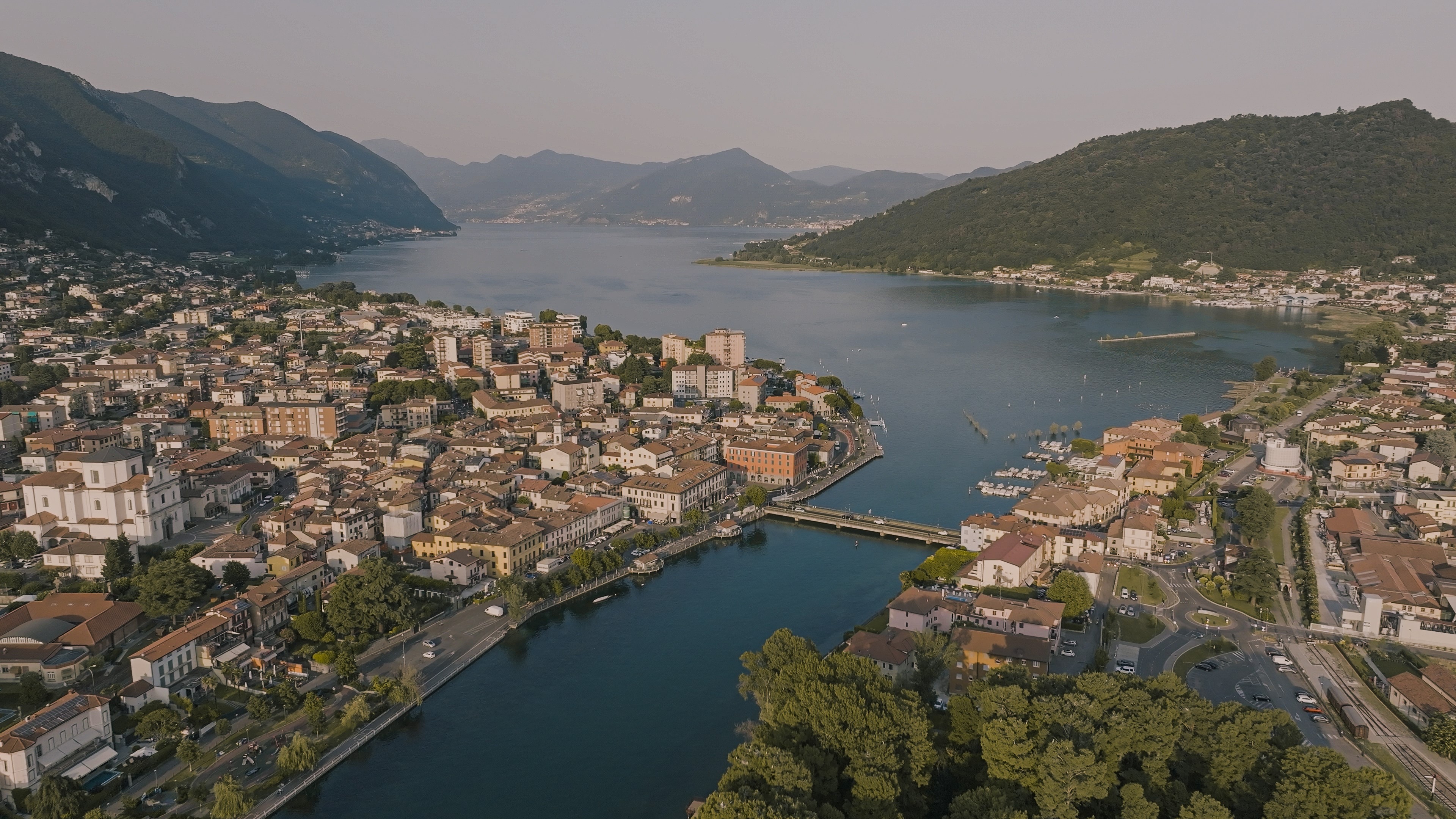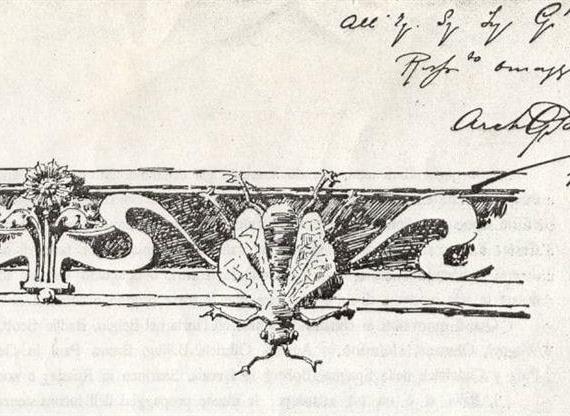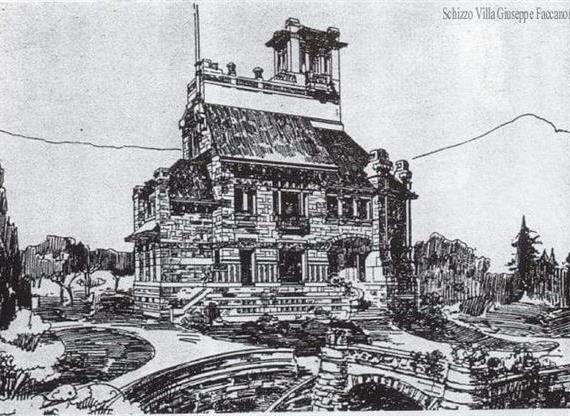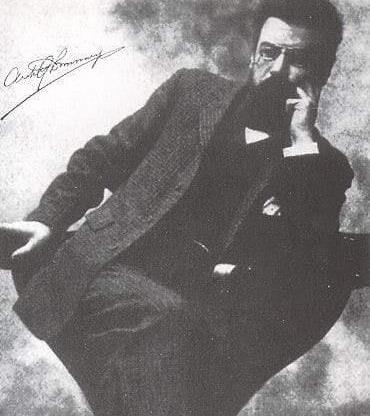
Ch. 2 - GIUSEPPE SOMMARUGA
Milan 1867-1917 / Italian architect
From a family of crafts decorators, he was a pupil of C. Boito at the Academy of Brera, but very soon reacted to the historicist attitude of his master, opposing his search for an architecture capable of finding in itself, in terms of organic vitality, the reason of its own style.
The undisputed promoter of Milanese architecture between the nineteenth and twentieth centuries, he is the leader of a modernist trend which, assuming particular accents, determines the characteristics Italian LIBERTY style. At the beginning of the century, he was already considered, along with Moretti, the most representative figure of the young generation of Milanese architects.
However, there is very little literature on Sommaruga. The most significant writings are those published in his lifetime or on the death of the architect: the notes by Melani for the Palazzo Castiglioni and a monograph written by Monneret de Villard which, as it was published in 1908, could not mention the major works such as the villas for the Faccanoni family. In 1914, an intelligent contribution was made by G.U. Arata, amongst the few who can be considered direct followers of Sommaruga. After the death of Sommaruga, commented on by two excellent articles, one again by Aratsa and the other by Luigi Angelini, no other general and recapitulative study on his work has ever been published. In 1982 a catalogue on Sommaruga came out, edited by E. Bairati and D. Riva. Laterza is due to publish a work on Sommaruga in its series “The Architects” for 1997. the dispersion of autographed material by the architect has contributed to this oblivion as the archives of his studio have not been traced. Very probably all his papers were dispersed as was the case for many architects of the period. Consequently, there are none of his sketches, original work material, or writing, such as the dry technical reports that sometimes accompany those of his designs which are kept in public archives. The image that we have of Giuseppe Sommaruga is a reflection mediated through his works and the accounts of the period. His physical image can be seen in the small photo used for obituaries or in the more personal photograph, published in “Emporium” in Bergamo in 1917.
At the end of his brief but intense career, Sommaruga was an outstanding personality in Milanese circles: honorary member and director of the Academy of Brera, member of the commission of the Veneranda Fabbrica del Duomo, didactic director of the School of Drawing of Canzo and Chairman of the Association of Architects of Lombardy.
Towards the end of his life, he was a member of the Higher Council of Fine Arts and the first chairman of the National Federation of Italian Architects. His achievements also meant social affirmation and personal prestige which can be followed emblematically in the architect’s different places of residence. From Via Marsala 2, where he lived when he was a student with his parents, after his first successes he moved to Foro Bonaparte 50 and then to addresses in the noble heart of old Milan: from Via Lanzone 31, in the old building owned by his father-in-law, to Via Unione 5 and then to Via Amedei 11, where Sommaruga lived in the last year of his life.
From his obituaries, all that is known is that his wife’s name was Adelina Volonteri, his daughter Elisa, his brothers Giovanni and Cesare, and his father-in-law Antonio Volonteri.
His professional training
Sommaruga’s training (courses at the Academy of Fine Arts of Brera in Milan: 1883-1887) was no different from that of the majority of architects of his generation. The choice of studies at the Academy, traditional for those intending to devote themselves to architecture, reveals the prestige that the academic institution still enjoyed in that period, although it had been suffering since after the Unity of Italy from a deep crisis in the contents and methods of teaching.
Sommaruga had an average performance with some prizes in the courses of ornamentation and architecture, a couple of awards in academic competitions, and a surprising failure in his examinations for qualification as a teacher of architectural drawing.
He did not learn very much at the Academy: the various techniques of drawing, skill, and confidence in his hand, a good knowledge of architectural “styles” and a smattering of the history of art.
He learned almost nothing on the technical, scientific, and practical side and next to nothing in general knowledge. The Academy diploma which was the qualification to teach drawing and allowed taking part in architecture competitions, did not have any legal value for the purposes of exercising the profession, which was granted only to graduates in civil architecture from the universities.
However, in his student years, Sommaruga’s choice of academic curriculum was still the predominant one, as shown by the low number of graduates from the architecture course at the Polytechnic.
The still elitist character of the school of architecture is justified by the greater weight (including economics) of the studies at the Polytechnic compared to the Academy. This confused situation, which had serious effects at the professional level, had created an evident dichotomy between the “technical architects” (Polytechnic graduates) and the “artistic architects” (with a diploma from the Academy of Fine Arts).
His teacher at the Brera Academy of Milan, CAMILLO BOITO (1836-1914), an interesting historian and defender of a “national architecture”, inspired by the anti-classic controversy led for thirty years in England by Ruskin and in France by Viollet-le-Duc, was a guarantee of good training in his early activity, but in the end, Sommaruga turned out to be anti-Boito.
His early activity (1895-1900, prior to Palazzo Castiglioni in Milan) belongs to eclecticism but is completely extraneous to historicism in the style of Boito. Sommaruga must have been lucidly aware of the limits of his academic education, perhaps not so much regarding his architectural culture, but regarding technical competence, the practical side, and professional outlets.
He ensured that he obtained the qualifications allowing him to exercise the profession of architect: the diploma as master mason from the school for master mason that Boito himself recommended to his Brera students and the essential period of apprenticeship with a well-known firm of architects which opened up the way to exercise the profession for those with diplomas from the Academy.
The choice of the firm of LUIGI BROGGI (perhaps suggested by Boito) was successful and profitable. Broggi had solid and complete training (a diploma from Brera and a degree from the Polytechnic in 1875), a first-class professional competence and he was very up-to-date on the situation of European architecture, thanks to several journeys abroad. For this reason, it is probable that the influence of Broggi on the young Sommaruga was greater and more productive than that of “Professor” Boito.
In 1890 the name of Sommaruga appeared for the first time on the national scene with Broggi with their prize-winning design in the competition for the Place of the Parliament in Rome.
Sommaruga also successfully participated in the 1st Italian Exhibition of Architecture in Turin in 1890, certainly through the good offices of Broggi. He also found the space for his first independent work (the Theobroma chalet) at the National Exhibition for Child Hygiene and Education in Milan (1891). Sommaruga probably concluded his apprenticeship at this stage. He again sat for the examinations in 1890, when he had obtained his first professional success working with Broggi and he passed. When he collected his diploma in 1891, his headed notepaper already bore the title of “architect”.
From that moment onwards, he had a closely packed series of public appointments, including chairman of the Building Committee of the City of Milan for several years.
Whilst the municipal technical departments, with flocks of civil engineers and master masons busy designing the service buildings needed for urban growth meeting the new requirements of the development of cities in post-unification of Italy, monumental and representative architecture (commemorative monuments, memorials to the glories of the motherland, parliament buildings and courts of law, museums and monumental cemeteries) seem to be left exclusively to “artist-architects”.
The national and international competitions called for these works to be of use to the young diploma holders from the academies. Winning a competition or being noticed represented a qualification to enter the employment market with some possibility of success.
Sommaruga was all too aware of this and, especially during the period of his early activity, took part in all competitions.
The Joint Exhibitions of Milan in 1894, where Sommaruga was the chief architect, officially put him in the professional Milanese ranks-opening the doors to private clients who had guessed the uncommon talent of the young architect.
Sommaruga had perfectly understood that success would also come from being totally open to the needs of clients or at the very least from a capacity to satisfy them with accurate work, quickly done and reasonable from an economic point of view.
What can be read in the comments in the margin to descriptions of work that appeared in the specialist journals of the period (“L’edilizia moderna”, “Il Monitore Tecnico”) is, on the one hand, the image of a professionally qualified architect, capable of taking on the most disparate problems with technical competence and on the other that of a versatile “artist” who gave the laborers under him the sketches or models he himself had drawn of the decorative elements (from ironwork to cement, from plaster to fresco decorations).
Sommaruga is a complete designer of the architectural object and therefore inserted into the modernist logic of design.
His great openness of those years soon bore fruit; his clients soon left him carte blanche, allowing him to do things “in a big way”, which was undoubtedly more suited to his personality. This twofold image as a technician and as an “artist” was to accompany him throughout his career.
Some of the most important clients of Sommaruga were engineers (Castiglioni, Salmoiraghi, Comi, Faccanoni, and Carosio) and it is no coincidence that they belonged to the upper bourgeoisie of the entrepreneurial class who were technically and culturally up-to-date, presenting analogies with the middle-class in the industrialized countries of Europe.
The architecture of Giuseppe Sommaruga
What does Giuseppe Sommaruga’s architecture represent? Italian Liberty, without a doubt.
In Lombardy the Liberty style finds in this architect one of the most complete expressions (Palazzo Castiglioni, 1903), in the symbolic transcription of volumes, the use of materials, and the decorative elements where the ashlar work gives a particular plastic significance to the surface, referring, with extreme freedom and topicality to elements of the historical tradition, reinterpreted with great expression.
But the architect is also a singular case of an autonomous style, the complex culture of international origin which does not completely eliminate independent peculiarities.
Sommaruga was well aware of the master concept of the whole modernist idea, the first elementary inspirational nucleus.
In the words of critics, there is no shortage of references to precise historical styles quoted as sources of inspiration for Sommaruga’s architectonic style. The Baroque, the models of which the architect is believed to have understood as “the prime aim of every architecture is that of expressing itself with a powerful play of masses” (which can be seen in some layouts such as the Hotel Tre Croci or the nearby Restaurant which certainly represent the most mature result of Sommaruga’s use of space).
The Romanesque, from whose masters he gained the capacity of expertly distributing decoration.
On close examination, tradition effectively played an important role in Sommaruga’s formation.
Although having an architectural culture that is still strongly provincial and bound to eighteenth-century typologies, Sommaruga reached a result of considerable expressive strength, as already mentioned, in the Palazzo Castiglioni in Corso Venezia in Milan, the outside of which appears literally “hollowed out” and modified in the traditional ratios of full and hollow, by the large entrance hall with several floors where the staircase is.
The theme of the dialect relationship between architecture and sculpture with E. Bazzano and A. Pirovano is almost like a personal signature, like the famous inserts with cupids disseminated on villas and tombs.
In the design of wrought iron (A. Mazzucotelli), there can be seen the dry linear essentiality of the support and the continuous spiraling of the favorite ribbon-shaped motif.
The floral element is the third note which does not blossom from the base combination but is interwoven and at times even superimposed.
The preface by Monneret de Villard to the volume on the architecture of Giuseppe Sommaruga states:
“Italy was late in following on the ferments of Art Nouveau, but although last it was able, with the impetus and impulse which are characteristic of Latin blood, to conquer one of the first places and amongst the artists who have made the greatest contribution to this victory, a leading position must be given to Giuseppe Sommaruga”.
Places, Villas and Funeral Architecture
The fateful meeting with a young engineer called Castiglioni took place in Milan in 1903, allowing Sommaruga to build the spectacular mansion in Corso Venezia at no. 73 (today 47), leading to immediate fame.
With this building, Giuseppe Sommaruga began a close collaboration, almost teamwork, with various prestigious craftsmen: the maestro of wrought iron, ALESSANDRO MAZZUCOTELLI, the cabinet-maker QUARTI and the sculptors-craftsmen AMBROSIO PIROVANO and ERNESTO BAZZARO. The second major encounter came about in 1907 with the FACCANONI family of engineers and businessmen from Sarnico on Lake Iseo, who had made their name with a series of public works of great importance in Trieste and Vienna. They established an extraordinary relationship between architect and client with Sommaruga, influencing the architect’s professional activity for several years.
Initially, it was Luigi Faccanoni who commissioned the villa in Via Buonarroti from Sommaruga where Sommaruga “moved” the famous and Junoesque statues that had shocked the conformist Milanese society when they appeared on the pediment of the very central Palazzo Castiglioni (nicknamed “Ca’ dei Ciapp” for this reason). The villa was then bought by an engineer called Romeo (Alfa Romeo) to become the present-day Columbus Nursing Home.
Pietro Faccanoni called on Sommaruga that year to restore a pre-existing industrial building, a spinning mill, to be converted into a villa.
The other two brothers, Luigi and Giuseppe, commissioned two new villas from the Milanese architect. Then there was the mausoleum for the Faccanoni Family and the kindergarten in 1912.
Sommaruga designed, built, re-elaborated, decorated, and furnished for the Faccanonis, using a team of first-class collaborators who were able to translate his ideas in an exemplary manner.
The production of his last period was for the most part outside Milan and even outside Lombardy.
Villas in Baveno, Stesa, Lanzo d’Intelvi, Varese, Campo dei Fiori and Treviso. A mansion and a theatre in Trieste, large hotels in Varese, Campo dei Fiori. Tombs: from the ossuary in Palestro to the Faccanoni mausoleum in Sarnico, as well as various family chapels; miscellaneous buildings for public use such as the series of tram stations for the Società Imprese Elettriche Varesine, of very great interest and completely ignored by literature. Unfortunately, many works have been destroyed.







